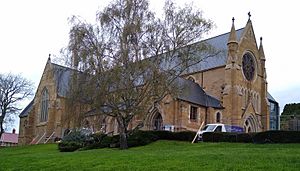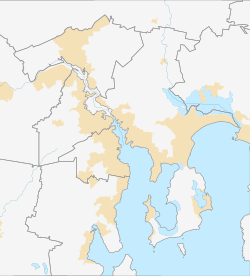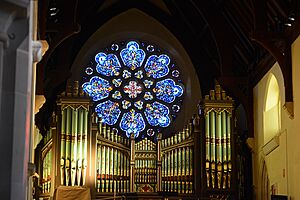St Mary's Cathedral, Hobart facts for kids
Quick facts for kids St Mary's Cathedral |
|
|---|---|

St Mary's Cathedral, Hobart
|
|
| 42°52′52″S 147°19′09″E / 42.88111°S 147.31926°E | |
| Location | Hobart, Tasmania |
| Country | Australia |
| Denomination | Catholic |
| History | |
| Status | Cathedral |
| Founded | 12 September 1860 |
| Dedication | Sacred Heart |
| Dedicated | 29 June 1865 rededicated 23 January 1881 |
| Consecrated | 14 July 1866 |
| Architecture | |
| Functional status | Active |
| Architect(s) |
|
| Architectural type | Cathedral |
| Style | Gothic Revival architecture |
| Years built |
|
| Groundbreaking | 1860 |
| Specifications | |
| Length | 26 metres (84 ft) |
| Width | 16 metres (52 ft) |
| Nave width | 5.5 metres (18 ft) |
| Nave height | 5.8 metres (19 ft) |
| Materials | Sandstone |
| Bells | Ring of 10 Bells and two semitones |
| Administration | |
| Parish | Cathedral |
| Archdiocese | Archdiocese of Hobart |
| Province | Hobart |
St Mary's Cathedral is a very important Catholic church in Hobart, Tasmania, Australia. It is the main church, or "seat," for the Roman Catholic Archbishop of Hobart, who is currently Julian Porteous.
The church's story began in 1822. That's when the first permanent priest in Tasmania, Philip Conolly, built a small wooden chapel. This chapel was near where the cathedral stands today. He dedicated it to God, in honor of an "Irish Saint" named St. Virgilius.
Contents
Where is St Mary's Cathedral?
St Mary's Cathedral is located on Harrington Street in Hobart. It is a special place of worship for the Catholic community in Hobart.
Right next to the cathedral is St Mary's College. Students from the college often attend Mass at the cathedral. This helps them celebrate the Catholic liturgical year.
The History of the Cathedral
The first foundation stone for the cathedral was laid in 1860. It was designed by William Wardell, who was a student of a famous architect named Augustus Pugin. The cathedral was officially opened and blessed in 1866. It was built in the Gothic Revival style, which looks like old European cathedrals.
However, there were some problems with how the cathedral was built. Because of these issues, much of it had to be taken apart. It was then rebuilt with a new design. This new design was still based on Wardell's original plans. The rebuilding was done by a Hobart architect named Henry Hunter. He laid the new foundation stone in 1878.
Inside the cathedral, there is a Norman-era baptismal font. This is a special bowl used for baptisms. It is thought to have connections to the architect Pugin. A historian noted that its detailed design looks like work from around 1170 to 1200.
The Cathedral Organ
The very first organ at St Mary's Cathedral was later moved. It went to the Sacred Heart Catholic Church in New Town.
The organ you see in the cathedral today was built in 1893. It was made by a company called Fincham & Hobday. This organ was first shown at a big event called the International Exhibition of Industry, Science and Art in Hobart in 1894. It even won first prize there!
The organ was then installed in St Mary's Cathedral in June 1895. Over the years, it has been updated and repaired several times. These updates happened in 1934, 1957, 1966, and most recently from 2007 to 2009.
Beautiful Stained Glass Windows
The cathedral has many beautiful stained glass windows. One of the most stunning is the Hardman Studio window. It looks like a Gothic window from the 1300s. This large window has five tall, narrow sections. These sections show important scenes from the Gospels. The detailed designs at the top of the window show images of heaven. This window was created in 1869.
Other special windows in the cathedral include:
- The rose window at the west end of the cathedral, made in 1981.
- The Pentecost window, added in 1989.
- The Heroic and Saintly Women window, installed in 1995.
See also
 In Spanish: Catedral de Santa María (Hobart) para niños
In Spanish: Catedral de Santa María (Hobart) para niños



